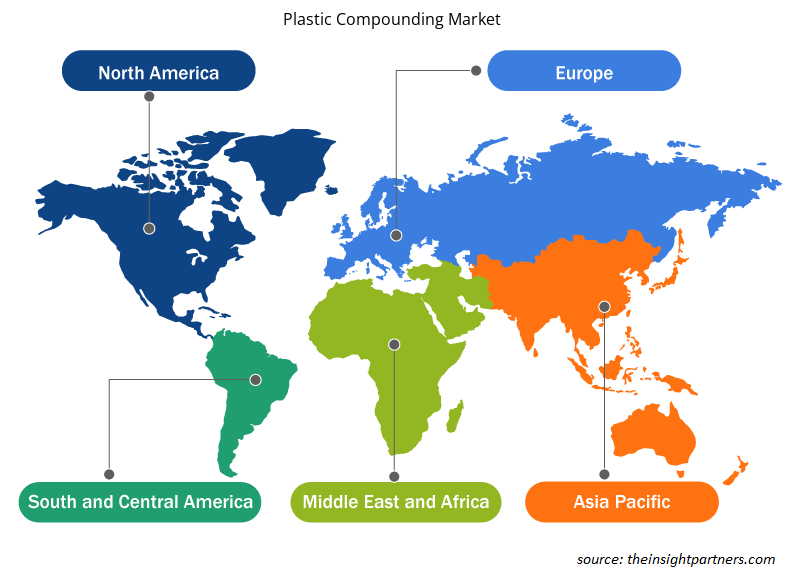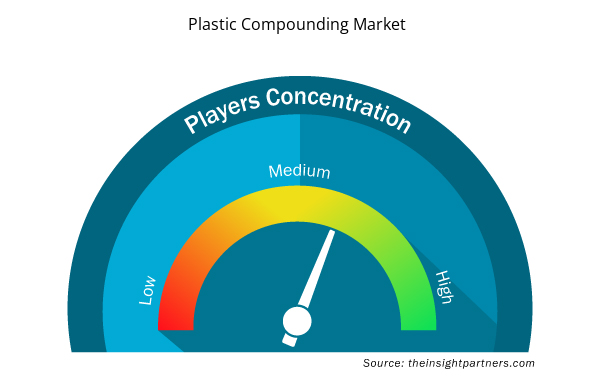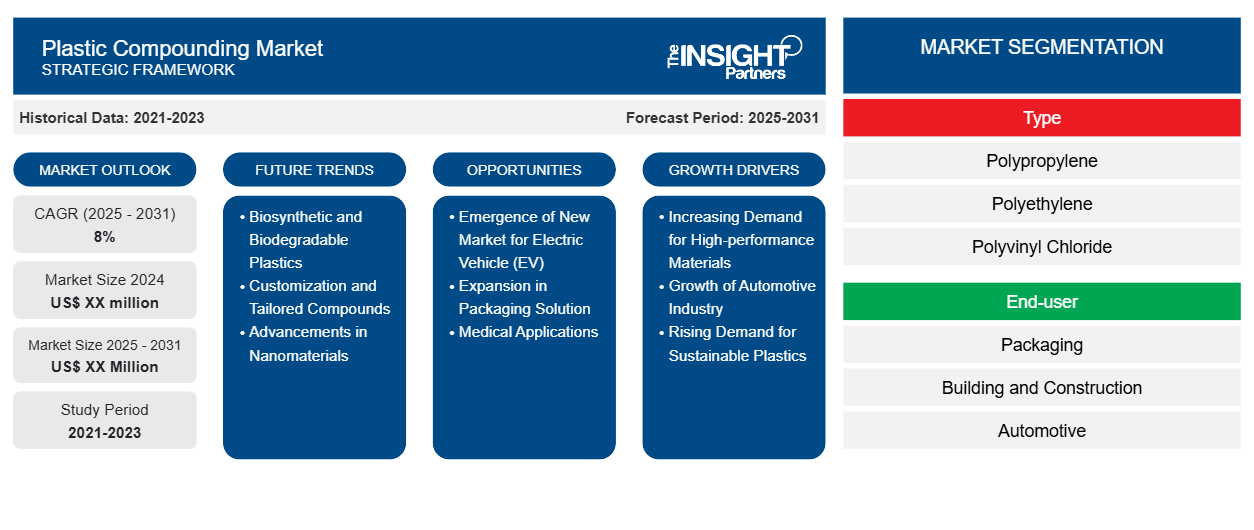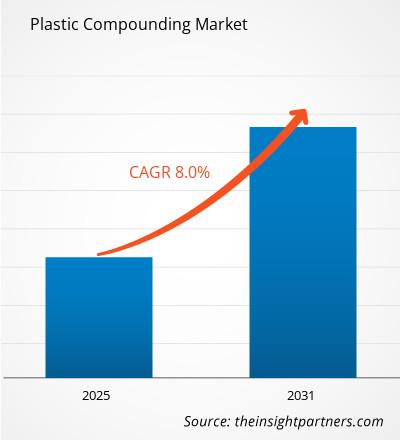Es wird erwartet, dass der Markt für Kunststoffmischungen von 2023 bis 2031 eine durchschnittliche jährliche Wachstumsrate (CAGR) von 8 % verzeichnet, wobei die Marktgröße von XX Millionen US-Dollar im Jahr 2023 auf XX Millionen US-Dollar im Jahr 2031 anwachsen wird.
Der Markt für Kunststoffmischungen umfasst Analysen nach Typ (Polypropylen (PP), Polyethylen (PE), Polyvinylchlorid (PVC), Polystyrol (PS) und expandiertes Polystyrol (EPS), Polyethylenterephthalat (PET), Polyurethan (PU), Acrylnitril-Butadien-Styrol (ABS), Sonstige); Endverbraucher (Verpackung, Bauwesen, Automobil, Elektrik und Elektronik, Sonstige) und Geografie (Nordamerika, Europa, Asien-Pazifik, Naher Osten und Afrika sowie Süd- und Mittelamerika). Bei der Kunststoffmischung werden Kunststoffformulierungen durch Vermengen und Vermischen von Polymeren und Additiven hergestellt. Die Automobilindustrie ist immer auf der Suche nach leichteren und günstigeren Materialien, um das Fahrzeuggewicht zu reduzieren und die Effizienz zu steigern; dieser Faktor treibt das Wachstum des Marktes für Kunststoffmischungen voran.
Zweck des Berichts
Der Bericht „Plastic Compounding Market“ von The Insight Partners soll die aktuelle Landschaft und das zukünftige Wachstum sowie die wichtigsten treibenden Faktoren, Herausforderungen und Chancen beschreiben. Dies wird verschiedenen Geschäftspartnern Einblicke geben, wie zum Beispiel:
- Technologieanbieter/-hersteller: Um die sich entwickelnde Marktdynamik zu verstehen und die potenziellen Wachstumschancen zu kennen, damit sie fundierte strategische Entscheidungen treffen können.
- Investoren: Durchführung einer umfassenden Trendanalyse hinsichtlich der Marktwachstumsrate, der finanziellen Marktprognosen und der Chancen entlang der Wertschöpfungskette.
- Regulierungsbehörden: Zur Regulierung von Richtlinien und Überwachungsaktivitäten auf dem Markt mit dem Ziel, Missbrauch zu minimieren, das Vertrauen der Anleger zu bewahren und die Integrität und Stabilität des Marktes aufrechtzuerhalten.
Marktsegmentierung für Kunststoffcompounds
Typ
- Polypropylen
- Polyethylen
- Polyvinylchlorid
- Polystyrol und expandiertes Polystyrol
- Polyethylenterephthalat
- Polyurethan
- Acrylnitril-Butadien-Styrol
Endbenutzer
- Verpackung
- Bauwesen
- Automobilindustrie
- Elektrik und Elektronik
- Sonstiges
Passen Sie diesen Bericht Ihren Anforderungen an
Sie erhalten kostenlose Anpassungen an jedem Bericht, einschließlich Teilen dieses Berichts oder einer Analyse auf Länderebene, eines Excel-Datenpakets sowie tolle Angebote und Rabatte für Start-ups und Universitäten.
- Holen Sie sich die wichtigsten Markttrends aus diesem Bericht.Dieses KOSTENLOSE Beispiel umfasst eine Datenanalyse von Markttrends bis hin zu Schätzungen und Prognosen.
Wachstumstreiber auf dem Kunststoffcompoundiermarkt
- Steigende Nachfrage nach Hochleistungsmaterialien: Die Anforderungen an die Leistungsfähigkeit von Materialien steigen drastisch: Hochleistungsmaterialien sind definitiv sehr gefragt, zumindest in fortgeschrittenen Entwicklungsstadien – Kunststoffe mit maßgeschneiderten Eigenschaften wie Festigkeit, Hitzebeständigkeit und elektrische Leitfähigkeit. Branchen wie die Automobil-, Elektronik- und Luftfahrtindustrie, die in großem Umfang Verbundkunststoffe verwenden, um Leistungsanforderungen zu erfüllen, heizen die immer höheren Anforderungen an maßgeschneiderte Kunststoffformulierungen zusätzlich an.
- Wachstum der Automobilindustrie: Der Automobilsektor ist einer der größten Kunststoff-Compoundiersektoren. Er befasst sich mit der Frage, welche Eigenschaften er hat, wie leichte, kraftstoffsparende Fahrzeuge, für die Compounding-Kunststoffe eine Lösung darstellen. Gewichtsreduzierung bei gleichzeitig erhöhter Festigkeit und Haltbarkeit wird alle Teile im Automobilbereich beeinflussen. Polypropylen und Polyamid werden häufig für Teile wie Stoßstangen, Armaturenbretter und Innenverkleidungen verwendet.
- Steigende Nachfrage nach nachhaltigen Kunststoffen: Umweltfreundliche Kunststoffe: Eine dieser Bewegungen aufgrund des größeren Umweltbewusstseins ist die Hinwendung zu nachhaltigen und recycelbaren Materialien zur Verwendung als Kunststoff. Die Compounding-Technologien für Kunststoffe bieten die Möglichkeit, recycelte Harze, biobasierte Kunststoffe und Additive zu verwenden, um die Recyclingfähigkeit und Umweltfreundlichkeit von Kunststoffprodukten zu verbessern. Daher können alle neuen Dinge in Marktwachstum mit strengeren Vorschriften und Nachhaltigkeitszielen umgesetzt und daran gemessen werden.
Zukünftige Trends auf dem Markt für Kunststoffcompounds
- Biosynthetische und biologisch abbaubare Kunststoffe: Mit der zunehmenden Anwendbarkeit nachhaltiger Materialien werden biobasierte und biologisch abbaubare Kunststoffformulierungen entstehen. Unternehmen werden Kunststoffformulierungen entwickeln, die aus erneuerbaren Rohstoffen gewonnen werden und umweltfreundlich sein können, ohne die Marktleistungskriterien herkömmlicher Kunststoffe zu beeinträchtigen.
- Anpassung und maßgeschneiderte Compounds: Die zunehmende Spezialisierung der Anforderungen wird sich in den kommenden Anwendungen des Marktes für Kunststoffcompounds widerspiegeln, die aus maßgeschneiderten Formulierungen für die Branchen erstellt werden. Die Spezialisierungen reichen wahrscheinlich von spezifischen Compounds für Fensteranwendungen – für hohe Temperaturen im Automobilsektor – bis hin zu größerer Transparenz beim Umgang mit Verpackungen.
- Fortschritte bei Nanomaterialien: Dies ist einer der Megatrends bei der Kunststoffmischung: Nanotechnologie wird bei der Kunststoffmischung eine sehr große Rolle spielen. Darüber hinaus ergeben sich neue Anwendungsmöglichkeiten, bei denen Nanomaterialien Kunststoffen verbesserte mechanische, thermische und elektrische Eigenschaften verleihen – ein Vorteil, der im Grunde neue Wege für Hochleistungsmaterialien in Branchen wie der Elektronik-, Automobil- und Verpackungsindustrie eröffnet.
Marktchancen für Kunststoffcompounds
- Entstehung eines neuen Marktes für Elektrofahrzeuge (EV): Das Volumen von Elektrofahrzeugen lässt eine große Zukunft für die Kunststoffmischung erwarten. Leichte, leistungsstarke, hochtemperaturbeständige und elektrisch isolierende Materialien werden bei der Verwendung in eingebetteten elektrischen Komponenten hohe Anforderungen stellen. Verbundkunststoffe könnten eine wichtige Rolle bei EV-Teilen wie Batteriegehäusen, Innenverkleidungen und Verkabelungsanwendungen spielen, die ein bedeutendes Wachstumsfeld darstellen werden.
- Erweiterung der Verpackungslösungen: Dies eröffnet neue Möglichkeiten für die Kunststoffmischung, bei denen nachhaltige Verpackungen verfolgt werden. Dies würde der Herstellung von Verpackungsmaterialien aus biobasierten, recycelbaren oder kompostierbaren Kunststoffmischungen mit einem klaren Schwerpunkt auf von der Natur hergestellten Produkten einen Impuls verleihen. Daher werden die Anwendungsmethoden bei Verbraucherprodukten wie Lebensmitteln, Getränken usw. immer beliebter.
- Medizinische Anwendungen: Diese Branche kann aufgrund ihrer ständig wachsenden Zusammensetzung in die Kategorie der medizinischen Anwendungen eingeordnet werden, insbesondere für medizinische Geräte im Bereich Verpackung und Pharmazeutika. Dies wird daher zu Produktionslinien für Kunststoffe führen, die mit Biokompatibilität, Sterilisationsbeständigkeit und hoher Haltbarkeit in medizinische Geräte und Verpackungslösungen eingearbeitet werden.
Regionale Einblicke in den Kunststoffcompoundierungsmarkt
Die regionalen Trends und Faktoren, die den Markt für Kunststoffmischungen im Prognosezeitraum beeinflussen, wurden von den Analysten von Insight Partners ausführlich erläutert. In diesem Abschnitt werden auch die Marktsegmente und die Geografie für Kunststoffmischungen in Nordamerika, Europa, im asiatisch-pazifischen Raum, im Nahen Osten und Afrika sowie in Süd- und Mittelamerika erörtert.

- Erhalten Sie regionale Daten zum Markt für Kunststoffmischungen
Umfang des Marktberichts zur Kunststoffcompoundierung
| Berichtsattribut | Details |
|---|---|
| Marktgröße im Jahr 2023 | XX Millionen US-Dollar |
| Marktgröße bis 2031 | XX Millionen US-Dollar |
| Globale CAGR (2023 - 2031) | 8 % |
| Historische Daten | 2021-2022 |
| Prognosezeitraum | 2024–2031 |
| Abgedeckte Segmente | Nach Typ
|
| Abgedeckte Regionen und Länder | Nordamerika
|
| Marktführer und wichtige Unternehmensprofile |
|
Dichte der Marktteilnehmer für Kunststoffmischungen: Auswirkungen auf die Geschäftsdynamik verstehen
Der Markt für Kunststoffmischungen wächst rasant, angetrieben durch die steigende Nachfrage der Endverbraucher aufgrund von Faktoren wie sich entwickelnden Verbraucherpräferenzen, technologischen Fortschritten und einem größeren Bewusstsein für die Vorteile des Produkts. Mit steigender Nachfrage erweitern Unternehmen ihr Angebot, entwickeln Innovationen, um die Bedürfnisse der Verbraucher zu erfüllen, und nutzen neue Trends, was das Marktwachstum weiter ankurbelt.
Die Marktteilnehmerdichte bezieht sich auf die Verteilung der Firmen oder Unternehmen, die in einem bestimmten Markt oder einer bestimmten Branche tätig sind. Sie gibt an, wie viele Wettbewerber (Marktteilnehmer) in einem bestimmten Marktraum im Verhältnis zu seiner Größe oder seinem gesamten Marktwert präsent sind.
Die wichtigsten auf dem Markt für Kunststoffmischungen tätigen Unternehmen sind:
- BASF SE
- Asahi Kasei Corporation
- Celanese Corporation
- Covestro AG
- Dow
Haftungsausschluss : Die oben aufgeführten Unternehmen sind nicht in einer bestimmten Reihenfolge aufgeführt.

- Überblick über die wichtigsten Akteure auf dem Markt für Kunststoffmischungen
Wichtige Verkaufsargumente
- Umfassende Abdeckung: Der Bericht deckt die Analyse von Produkten, Dienstleistungen, Typen und Endbenutzern des Kunststoff-Compoundierungsmarktes umfassend ab und bietet einen ganzheitlichen Überblick.
- Expertenanalyse: Der Bericht basiert auf dem umfassenden Verständnis von Branchenexperten und Analysten.
- Aktuelle Informationen: Der Bericht stellt durch die Abdeckung aktueller Informationen und Datentrends Geschäftsrelevanz sicher.
- Anpassungsoptionen: Dieser Bericht kann angepasst werden, um spezifische Kundenanforderungen zu erfüllen und die Geschäftsstrategien optimal anzupassen.
Der Forschungsbericht zum Markt für Kunststoffmischungen kann daher dabei helfen, die Branchensituation und Wachstumsaussichten zu entschlüsseln und zu verstehen. Obwohl es einige berechtigte Bedenken geben kann, überwiegen die allgemeinen Vorteile dieses Berichts tendenziell die Nachteile.
- Historische Analyse (2 Jahre), Basisjahr, Prognose (7 Jahre) mit CAGR
- PEST- und SWOT-Analyse
- Marktgröße Wert/Volumen – Global, Regional, Land
- Branche und Wettbewerbsumfeld
- Excel-Datensatz



Report Coverage
Revenue forecast, Company Analysis, Industry landscape, Growth factors, and Trends

Segment Covered
This text is related
to segments covered.

Regional Scope
North America, Europe, Asia Pacific, Middle East & Africa, South & Central America

Country Scope
This text is related
to country scope.
Häufig gestellte Fragen
The North America market is expected to account for the highest CAGR during the forecast period owing to the growing automotive sector in the region.
The automotive end user segment accounted for the largest market share in 2023
BASF SE, Asahi Kasei Corporation, Celanese Corporation, Covestro AG, Dow, Kingfa Sci. and Tech. Co., Ltd., LyondellBasell Industries Holdings B.V., PolyOne, SABIC, and Solvay SA are some of the key players in the market.
Growing demand for high-performing materials is a key driver in the market.
The Plastic Compounding Market is estimated to witness a CAGR of 8% from 2023 to 2031
Growing demand for functional plastics is an emerging trend in the market.
Trends and growth analysis reports related to Chemicals and Materials : READ MORE..
1. BASF SE
2. Asahi Kasei Corporation
3. Celanese Corporation
4. Covestro AG
5. Dow
6. Kingfa Sci. and Tech. Co., Ltd.
7. LyondellBasell Industries Holdings B.V.
8. PolyOne
9. SABIC
10. Solvay SA
The Insight Partners performs research in 4 major stages: Data Collection & Secondary Research, Primary Research, Data Analysis and Data Triangulation & Final Review.
- Data Collection and Secondary Research:
As a market research and consulting firm operating from a decade, we have published and advised several client across the globe. First step for any study will start with an assessment of currently available data and insights from existing reports. Further, historical and current market information is collected from Investor Presentations, Annual Reports, SEC Filings, etc., and other information related to company’s performance and market positioning are gathered from Paid Databases (Factiva, Hoovers, and Reuters) and various other publications available in public domain.
Several associations trade associates, technical forums, institutes, societies and organization are accessed to gain technical as well as market related insights through their publications such as research papers, blogs and press releases related to the studies are referred to get cues about the market. Further, white papers, journals, magazines, and other news articles published in last 3 years are scrutinized and analyzed to understand the current market trends.
- Primary Research:
The primarily interview analysis comprise of data obtained from industry participants interview and answers to survey questions gathered by in-house primary team.
For primary research, interviews are conducted with industry experts/CEOs/Marketing Managers/VPs/Subject Matter Experts from both demand and supply side to get a 360-degree view of the market. The primary team conducts several interviews based on the complexity of the markets to understand the various market trends and dynamics which makes research more credible and precise.
A typical research interview fulfils the following functions:
- Provides first-hand information on the market size, market trends, growth trends, competitive landscape, and outlook
- Validates and strengthens in-house secondary research findings
- Develops the analysis team’s expertise and market understanding
Primary research involves email interactions and telephone interviews for each market, category, segment, and sub-segment across geographies. The participants who typically take part in such a process include, but are not limited to:
- Industry participants: VPs, business development managers, market intelligence managers and national sales managers
- Outside experts: Valuation experts, research analysts and key opinion leaders specializing in the electronics and semiconductor industry.
Below is the breakup of our primary respondents by company, designation, and region:

Once we receive the confirmation from primary research sources or primary respondents, we finalize the base year market estimation and forecast the data as per the macroeconomic and microeconomic factors assessed during data collection.
- Data Analysis:
Once data is validated through both secondary as well as primary respondents, we finalize the market estimations by hypothesis formulation and factor analysis at regional and country level.
- Macro-Economic Factor Analysis:
We analyse macroeconomic indicators such the gross domestic product (GDP), increase in the demand for goods and services across industries, technological advancement, regional economic growth, governmental policies, the influence of COVID-19, PEST analysis, and other aspects. This analysis aids in setting benchmarks for various nations/regions and approximating market splits. Additionally, the general trend of the aforementioned components aid in determining the market's development possibilities.
- Country Level Data:
Various factors that are especially aligned to the country are taken into account to determine the market size for a certain area and country, including the presence of vendors, such as headquarters and offices, the country's GDP, demand patterns, and industry growth. To comprehend the market dynamics for the nation, a number of growth variables, inhibitors, application areas, and current market trends are researched. The aforementioned elements aid in determining the country's overall market's growth potential.
- Company Profile:
The “Table of Contents” is formulated by listing and analyzing more than 25 - 30 companies operating in the market ecosystem across geographies. However, we profile only 10 companies as a standard practice in our syndicate reports. These 10 companies comprise leading, emerging, and regional players. Nonetheless, our analysis is not restricted to the 10 listed companies, we also analyze other companies present in the market to develop a holistic view and understand the prevailing trends. The “Company Profiles” section in the report covers key facts, business description, products & services, financial information, SWOT analysis, and key developments. The financial information presented is extracted from the annual reports and official documents of the publicly listed companies. Upon collecting the information for the sections of respective companies, we verify them via various primary sources and then compile the data in respective company profiles. The company level information helps us in deriving the base number as well as in forecasting the market size.
- Developing Base Number:
Aggregation of sales statistics (2020-2022) and macro-economic factor, and other secondary and primary research insights are utilized to arrive at base number and related market shares for 2022. The data gaps are identified in this step and relevant market data is analyzed, collected from paid primary interviews or databases. On finalizing the base year market size, forecasts are developed on the basis of macro-economic, industry and market growth factors and company level analysis.
- Data Triangulation and Final Review:
The market findings and base year market size calculations are validated from supply as well as demand side. Demand side validations are based on macro-economic factor analysis and benchmarks for respective regions and countries. In case of supply side validations, revenues of major companies are estimated (in case not available) based on industry benchmark, approximate number of employees, product portfolio, and primary interviews revenues are gathered. Further revenue from target product/service segment is assessed to avoid overshooting of market statistics. In case of heavy deviations between supply and demand side values, all thes steps are repeated to achieve synchronization.
We follow an iterative model, wherein we share our research findings with Subject Matter Experts (SME’s) and Key Opinion Leaders (KOLs) until consensus view of the market is not formulated – this model negates any drastic deviation in the opinions of experts. Only validated and universally acceptable research findings are quoted in our reports.
We have important check points that we use to validate our research findings – which we call – data triangulation, where we validate the information, we generate from secondary sources with primary interviews and then we re-validate with our internal data bases and Subject matter experts. This comprehensive model enables us to deliver high quality, reliable data in shortest possible time.


 Holen Sie sich ein kostenloses Muster für diesen Bericht
Holen Sie sich ein kostenloses Muster für diesen Bericht